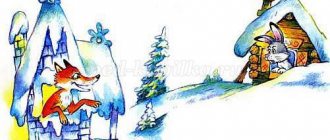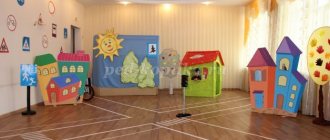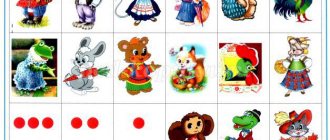Notes on speech development: Retelling the fairy tale “The Fox and the Goat”
Summary of a lesson on speech development (PREPARATION GROUP)
Retelling of the fairy tale "The Fox and the Goat"
Tasks. Connected speech:
consolidate children’s ideas about the features of the composition of fairy tales (beginning, ending); learn to use figurative artistic means when retelling, expressively convey the dialogues of characters;
Vocabulary and grammar:
learn to select definitions for nouns denoting objects and phenomena of the surrounding world, to find an object based on the named characteristics; when agreeing words, focus on their endings;
sound culture of speech:
learn to pronounce tongue twisters clearly and intelligibly with different voice volumes (loud, moderate, quiet, whisper); select words that are similar in sound and rhythm.
Material. Pictures of a fox.
Progress of the lesson
The teacher asks a riddle: “The tail is fluffy, the fur is golden - who is the riddle about?” (About a fox.) Shows the children several pictures of a fox: “When you were in the older group, you and I looked at different pictures. Now you can take any picture and say what kind of fox you have. If one has a red fox, then another has another... someone has a beautiful fox, and someone else..."
The teacher expressively tells the fairy tale “The Fox and the Goat.” Asking questions:
—What is this fairy tale about?
- How does it start? ends?
- How is the fox shown in the fairy tale? Why do you think she's cunning? How else is a fox depicted?
-What kind of goat is in the fairy tale? Why do you think he is like this?
— What words and expressions did you like best?
“Listen to the story again,” the teacher suggests, “then you will tell it.” Listen carefully and remember.
3-4 retellings are heard.
You can invite the children to retell the fairy tale in roles (or as a group - “team”).
Children evaluate their comrades' retellings. If they find it difficult, the teacher does it himself, drawing their attention to the completeness of the content, the expressiveness of intonation in the dialogue, the use of figurative words and expressions from the text.
The teacher addresses the children:
— You told the story interestingly and expressively. Let's think again about what it was
goat. What words can you use to describe him? (Slow-witted, stupid, unintelligent, inattentive, etc.)
-What was the fox like? (Red-haired, cunning, beautiful, smart, dexterous, fast, nimble.)
- What words that you said about the goat and the fox can be used when speaking about a person?
- What kind of well was it? (Deep, cold, dark, muddy, dirty, narrow.)
— What else can be called “cold”? (Snow, ice, air, wind...)
- What can be called “cold”? (Winter, snowflake, icicle, piece of ice...)
- Listen carefully and answer. Cold, deep, transparent -
is this a river or a stream?..
Blue, glass, fragile -
is this a saucer or a cup?
When conducting these exercises, the teacher makes sure that the children clearly pronounce endings and correctly agree adjectives with nouns.
The teacher suggests learning a tongue twister about a fox: “The fox runs along the six. Lick the fox, the sand.” The teacher and then the children pronounce the tongue twister loudly, moderately, quietly, in a whisper.
You can give the children the task of coming up with a rhyme for the words “Where have you been, little fox?” (Danced on the lawn; rested under a bush, etc.) Everyone repeats the most successful couplet loudly, quietly, in a whisper.
Fairy tale The Fox and the Goat read
A fox ran, gaped at the crow, and ended up in a well. There was not much water in the well: you couldn’t drown, and you couldn’t jump out either. The fox sits and grieves.
A goat is walking - a smart head. He walks, shakes his beard, shakes his faces; Out of nothing to do, he looked into the well, saw a fox there and asked:
What are you doing there, little fox?
“I’m resting, my dear,” the fox answers, “it’s hot up there, that’s how I climbed up here.” It's so cool and nice here! Cold water - as much as you want!
But the goat has been thirsty for a long time.
Is the water good? - asks the goat.
“Excellent,” the fox answers. - Clean, cold! Jump here if you want; There will be a place for both of us here.
The goat foolishly jumped and almost ran over the fox. And she told him:
Eh, the bearded fool, he didn’t even know how to jump - he splashed all over.
The fox jumped onto the goat's back, from the back onto the horns, and out of the well.
A goat almost disappeared from hunger in a well. They found him by force and dragged him out by the horns.
Target.
To improve children's ability to retell a fairy tale in person.
Progress of the lesson
“People always have to tell something in life,” the teacher tells the children, “where they were, what they saw, what happened; retell films, TV shows, the contents of books. That's why you and I are learning to tell and retell. It is very interesting to retell Russian folk tales. They contain dialogues and unusual words and expressions.
Today we will retell the Russian folk tale “The Fox and the Goat.”
The teacher reads a fairy tale.
Fox and goat
The Fox was running along the road, gaped at the crows and fell into the well. There is not much water in the well, you won’t drown if you drown, and you won’t jump out if you jump out. The Fox is sitting, grieving. What to do here? Here Goat is walking along the same road, waving his head, shaking his beard, looking around. Having nothing better to do, the Goat looked into the well. I saw Lisa there and asked:
- Great, Lisa. What are you doing here?
- Yes, I’m resting. It’s hot at the top, but here it’s cool, and there’s as much cold water as you want.
And the Goat has been thirsty for a long time.
- Is the water good?
“The water is good,” answers the Fox. - Yes, jump here and try it. There's enough room for two of us.
The goat foolishly jumped. He muddied the waters and almost ran over the Fox. The Fox got angry and scolded:
“Look, bearded guy, he couldn’t even jump, he got splashed all over.”
The Fox jumped onto the Goat's back, from the back onto the horns, and out of the well! Only Kozel saw her.
The Goat is sitting in the well. He sat there until the evening and didn’t know how to get out.
The owner of the Goat grabbed it and went looking. I searched and searched and found it with great effort. He brought the rope and pulled the Goat out of the well.
The teacher draws the children’s attention to the words that are used at the beginning of the fairy tale: you gape, if you drown, you won’t drown, but if you jump out, you won’t jump out.
.
“But Goat is walking along the same road. How is he going? – the teacher clarifies.
Then he reads out the dialogues of the Fox and the Goat and invites the children to repeat them. The teacher recites the text on behalf of the Goat, and the child pronounces the text on behalf of the Fox (2-3 repetitions).
The teacher reads the fairy tale again and calls three children to retell it. They retell the fairy tale with their faces down to the words: “The goat foolishly jumped...” It’s better to say these words to the teacher. And the excerpt “The Fox jumped onto the Goat’s back, from the back onto the horns, and out of the well. Only the Goat saw her,” the children say in unison.
Then the text is retold by other children.
Lesson 7. Tales of H. H. Andersen
Target.
Help children remember the fairy tales of H. H. Andersen they know.
Preliminary work.
Before class, children should read the fairy tales “Thumbelina”, “The Steadfast Tin Soldier”, “The Ugly Duckling”.
Progress of the lesson
The teacher reminds the children of the information they already know about H. H. Andersen: “Hans Christian Andersen was born in the small and very beautiful country of Denmark. He grew up in a poor family, and no one could have imagined that he would become a great storyteller.
Andersen loved the theater, wanted to become an artist, but he did not turn out to be an artist. He began to write plays for the theater, and later - to come up with various funny stories that people really liked.
He also loved to cut out wonderful human figures and ornaments from paper.
Andersen's fairy tales are known to children all over the world. And you also know his tales. Which?"
Children call fairy tales. The teacher finds out which fairy tale they especially liked. If a fairy tale is named that was not read to the children in class, the teacher asks the child to tell its content. Helps if necessary.
Lesson 8. Repetition
Repetition of covered material.
Lesson 1. Memorizing the poem “Motherland” by Z. Alexandrova
Target.
Help children understand the meaning of the poem (“Homeland can be different, but everyone has one”), remember the work.
Preliminary work.
The teacher places the text of the poem in the parent's corner and asks the parents to tell their children about that corner of our Motherland where they were happy and where, at least mentally, they returned more than once.
The teacher reads a poem to the children. He advises him to read it to his first teacher later.
Progress of the lesson
The teacher asks the children what their parents told them about.
“Think and answer a very difficult question,” says the teacher, “what is the Motherland?”
Listening to the children’s answers, the teacher draws their attention to related words: homeland - born
.
“Russia is our country,” the teacher continues the conversation. – Our Motherland is huge. It is diverse in climate and nature. If a person living in another country, for example in England, asks you: “Tell me about your homeland,” you will probably be at a loss, thinking about what to tell about. But if you remember your favorite corner of the Motherland, you will immediately find the words.
For example, I like to remember my grandmother’s house in the village, where from morning to evening we spent on a river with the purest water, in which crayfish lived under snags, and in the shallows tiny minnows gently nipped at our heels. Do you already have your favorite corners of the Motherland?”
The teacher listens to the children’s answers and reads Z. Alexandrova’s poem “Motherland” (abbreviated):
If they say the word “homeland,” the old house immediately comes to mind, there are currants in the garden, and a thick poplar at the gate.
By the river there is a modest birch tree and a daisy hill... And others will probably remember their native Moscow yard.
Or the steppe, red with poppies, golden virgin lands... The homeland can be different, but everyone has the same one!
“We remember who remembers what when they hear the word Motherland
? – the teacher asks the children.
One of the children reports what he remembers, and the teacher reads the corresponding lines of the poem.
The teacher repeats the first quatrain and invites the children to read it with him, but without a voice. Then these lines are read by 2-3 children.
The teacher repeats the quatrain and adds the second part of the poem to it. Then he asks the children to close their eyes and imagine a modest birch tree, a daisy hillock and their home yard. Reads the second four lines and asks 2-3 children to repeat them.
The teacher repeats the second quatrain and adds the third part of the poem to it. Explains what virgin gold is.
The children quietly pronounce the final words of the poem in chorus.
The teacher reads the poem in its entirety. Then he pronounces the author’s name and says the name of the poem.
Lesson 2. Sound culture of speech. Preparing for literacy
Target.
Improve phonemic awareness. Learn to perform sound and syllabic analysis of words.
Progress of the lesson
“I want to make sure that you are attentive in class and know how to work independently,” the teacher tells the children. – Today you will tell me the answers to the riddles in my ear. So, what two sounds made similar-sounding words different in meaning: bow - bough
?
You should answer like this: l, s
.”
The teacher offers the children the following pairs of words: poppy - cancer, mother - lama, com - scrap, com - catfish
.
“Now let’s play the game ‘I give you, you give me,’ says the teacher. – What parts does the word milk
?
(Mo-lo-ko.)
The teacher explains a new task to the children: they need to name all the sounds in a word, without skipping or rearranging them. For analysis, he offers words: juice (s, o, k), notes, dew, dust
.
The teacher, congratulating the children on the coming of spring, reads to them S. Yesenin’s poem “Bird Cherry”:
The fragrant bird cherry blossomed in spring and the golden branches curled like curls. All around, honey dew Slides down the bark, Beneath it, spicy greenery Shines in silver. And nearby, by the thawed patch, in the grass, between the roots, a small Silver stream runs and flows. The fragrant bird cherry stands hanging, and the golden greenery burns in the sun. The stream pours over all the branches like a thunderous wave, and insinuatingly sings songs to Her under the steep slope.
The teacher asks the children to repeat the sentence “A little silver stream is running and flowing” and in any way show how many words there are in it. Then he “distributes” words to the children. The guys say them one after another. If they get confused, the answer is not counted and the teacher “distributes” the words to other children.
The teacher reads the poem “Bird cherry” again and invites the children who wish to learn it by heart (in abbreviation).
Lesson 3. Spring poems
Target.
Help children feel the amazing uniqueness of poems about spring.
Progress of the lesson
The teacher asks the children what season is coming to an end and reminds them that May is the last month of spring.
“Spring is a long-awaited and fabulously beautiful time of year,” says the teacher, “that’s why poems about how nature transforms and blossoms are surprisingly bright and memorable. Shall we listen?
Reads three poems, for example, “Rural Song” by A. Pleshcheev, “The Willow is All Fluffy” by A. Fet, “Bird Cherry” by S. Yesenin.
Then he asks the children who liked which poem. He reads the one that most preschoolers remember.
The teacher reads two or three more poems, for example: “Lark” by V. Zhukovsky, “My little bells...” by A. K. Tolstoy, “Blue, pure snowdrop-flower...” by A. Maykov.
The teacher repeats the poem the children liked and asks the children to carefully look at the illustrations for the works they read and choose the one they like.
Target:
continue to teach children to retell the fairy tale close to the text.
Tasks:



